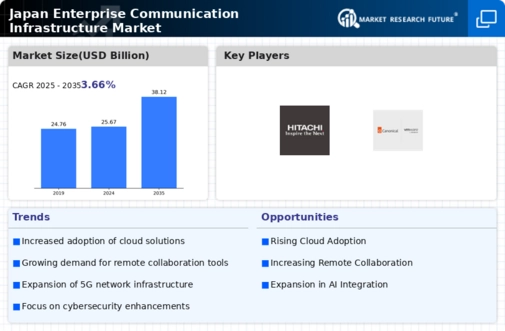Expansion of 5G Technology
The expansion of 5G technology is poised to have a transformative impact on the enterprise communication-infrastructure market in Japan. With its high-speed connectivity and low latency, 5G is expected to enhance communication capabilities across various industries. By 2025, it is anticipated that 5G adoption will reach 50% among enterprises, enabling more efficient data transfer and real-time communication. This technological advancement is likely to facilitate the deployment of advanced applications, such as augmented reality and IoT solutions, which require robust communication infrastructure. The integration of 5G technology is expected to drive innovation and growth within the enterprise communication-infrastructure market, as businesses leverage its capabilities to improve operational efficiency and customer engagement.
Increased Focus on Data Security
In the enterprise communication-infrastructure market, there is an increasing focus on data security and privacy. As businesses in Japan become more aware of the risks associated with data breaches, they are prioritizing secure communication solutions. In 2025, it is projected that 75% of organizations will invest in enhanced security measures for their communication infrastructure. This trend is driven by regulatory requirements and the need to protect sensitive information. Companies are adopting encryption technologies and secure access protocols to safeguard their communications. The emphasis on data security is likely to shape the enterprise communication-infrastructure market, as organizations seek to build trust with clients and stakeholders while ensuring compliance with local regulations.
Rising Demand for Remote Work Solutions
The enterprise communication-infrastructure market is significantly influenced by the rising demand for remote work solutions in Japan. As organizations adapt to flexible work arrangements, the need for robust communication infrastructure becomes paramount. In 2025, it is estimated that over 60% of companies will implement hybrid work models, necessitating reliable communication tools. This shift is prompting investments in cloud-based solutions that facilitate collaboration among remote teams. The enterprise communication-infrastructure market is likely to benefit from this trend, as businesses seek to enhance employee engagement and productivity through effective communication channels. The emphasis on remote work solutions is expected to drive market growth, as companies prioritize infrastructure that supports a distributed workforce.
Technological Advancements in Communication Tools
The enterprise communication-infrastructure market in Japan is experiencing a surge due to rapid technological advancements. Innovations in communication tools, such as VoIP, video conferencing, and collaboration platforms, are reshaping how businesses operate. As of 2025, the market is projected to grow at a CAGR of 8.5%, driven by the increasing demand for seamless communication solutions. Companies are investing in advanced infrastructure to enhance productivity and streamline operations. The integration of high-speed internet and mobile technologies further supports this growth, enabling real-time communication and collaboration across various sectors. This trend indicates a shift towards more efficient communication methods, which are essential for maintaining competitiveness in the evolving business landscape.
Growing Importance of Unified Communication Systems
The enterprise communication-infrastructure market is witnessing a growing importance of unified communication systems in Japan. These systems integrate various communication channels, such as voice, video, and messaging, into a single platform, enhancing collaboration and efficiency. As of 2025, it is estimated that the adoption of unified communication solutions will increase by 40% among enterprises. This trend is driven by the need for streamlined communication processes and improved user experiences. Organizations are recognizing the value of having a cohesive communication strategy that supports both internal and external interactions. The shift towards unified communication systems is likely to propel the enterprise communication-infrastructure market, as businesses seek to optimize their communication workflows.













Leave a Comment